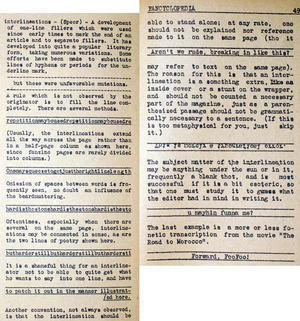Difference between revisions of "Interlineations"
| Line 8: | Line 8: | ||
Linos were an invention of [[Jack Speer]]’s. | Linos were an invention of [[Jack Speer]]’s. | ||
| + | |||
| + | A rarer form is the [[verticalineation]]. | ||
It is ''very'' difficult to reproduce [[typewriter]]-based typography in HTML, but we tried. A scan of the actual text from Fancy is below. | It is ''very'' difficult to reproduce [[typewriter]]-based typography in HTML, but we tried. A scan of the actual text from Fancy is below. | ||
Revision as of 19:48, 5 October 2020
An interlineation, or lino, is a one-line filler, typically used to take up space at the end of articles or separate sections in fanzines. It is set off between two straight lines, achieved on a typer with the underscore mark above and below, or between lines of hyphens, equal signs, tildes or other such marks.
Interlineations are rarely used online
The text can be anything: catchphrases, jokes, quotations, nonsensical remarks or, rarely, pull-outs from the articles.
Linos were an invention of Jack Speer’s.
A rarer form is the verticalineation.
It is very difficult to reproduce typewriter-based typography in HTML, but we tried. A scan of the actual text from Fancy is below.
| From Fancyclopedia 2, ca. 1959 |
| Lino
(1) interlineation; mostly a Briticism. (2) Short for linoblock; a means of reproduction something like the woodcut, except that you cut it out of a slab of linoleum (which is easier to carve) glued to a block of wood to make it type high. |
| From Fancyclopedia 2, ca. 1959 |
| (Speer) ("IN-ter-lin-A-shuns"; incorrectly pronounced "IN-ter-LI-ne-A-shuns" by people who forget that the "e" in line is silent. But hot words have been slung on this subject of pronunciation.) A development of one-line fillers which were used to mark the end of articles and separate fillers since early times. It has developed into quite a popular literary form, with numerous variations.
and this custom long defied efforts to substitute lines of periods or hyphens (courtesy Walt Willis) surrounding the phrase. The borders of the modern interlineation may extend all the way across the page or fit the length of the phrase set between them; the latter is always centered on the page except by the uncouth and those who fill the line from one side of the sheet to the other. The last custom is almost obsolete, as is the omission of spaces between words (probably an influence of the beardmuttering). - - - - - - - - - - - - - - - - - - - - - - - - - - - - - - - - - - - - - - - - - - - - - - - - - - - - - - Oftentimes, especially when there are several interlineations on the same page, they may be connected in sense, as are the two on either side of this sentence. - - - - - - - - - - - it's vagueness - - - - - - - - - - - Speer gives an instance of things that make good interlineations: "brilliant remarks wrencht out of context to make them twice as brilliant and three times as puzzling". The subject matter of the interlineation may be anything under the sun or in it, but it's most successful if a bit esoteric so that one must study it to guess what the editor had in mind. Another convention, not always observed, is that the interlineation should be able to stand alone, either as a complete epigram or an allusion to matters which if they are not well known refer to the text of the magazine in which it appears. It should not be spelled out to the reader nor otherwise directly referred to in the text, because an interlineation is something extra -- like an inside cover or a stunt on the wrapper -- and should not be counted a necessary part of the mag, just as a parenthesized passage should not be grammatically necessary for a sentence. (If this is too metaphysical for you, let it pass...). from Fancyclopedia 2 Supplement ca. 1960: The erroneous pronunciation interlin-e-ations comes from linear, in which the e is not silent. But interlineation comes from it being between lines, not occupying a line. |
| From Fancyclopedia 1, ca. 1944 |
| The typewriter tricks in this section are very difficult to duplicate in HTML. So, brought to you by the magic of scanning is the original: |
| Publishing |
